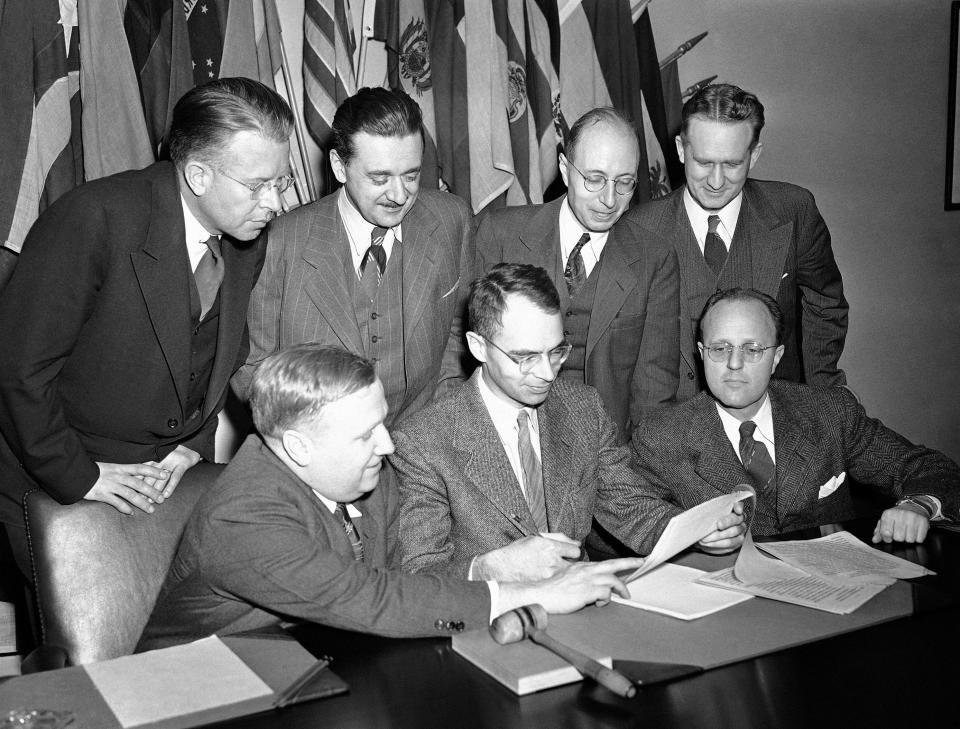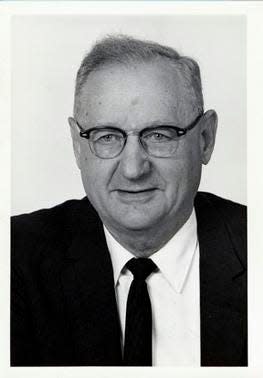How work at Iowa State made Oppenheimer's Manhattan Project and the atomic bomb possible
- Oops!Something went wrong.Please try again later.
With "Oppenheimer" hitting theaters July 21, many are remembering J. Robert Oppenheimer and his role in developing the atomic bomb. What some might not realize is that early nuclear pioneering that made his work possible took place right here in Iowa.
On Dec. 2, 1942, scientists joined together under the west stands of Stagg Field at the University of Chicago, bearing witness to the first ever self-sustained nuclear chain reaction.
Among the scientists were Dr. Frank H. Spedding and Dr. Harley A. Wilhelm of Iowa State College. The men worked on the Ames Project, which eventually became part of the Institute for Atomic Research.

"I believe all of us present realized that we were tapping a new form of energy which would greatly influence the course of human events," Spedding previously told the Ames Tribune.
Spedding included that he and his colleagues quickly became aware of the important potential the discovery had "for the welfare and happiness of the human race."
REVIEW: 'Oppenheimer' is a Christopher Nolan masterpiece. The contemporary echoes are terrifying
What role did 'The Ames Process' play in the Manhattan Project?
Spedding and Wilhelm's team in Ames was tasked with finding a more efficient method to purify uranium. Wilhelm himself became successful in finding a purification process, which came to be called "the Ames Process."
Spedding, Harley and their coworkers produced one-third of the 6 tons of uranium metal that created the Manhattan Project and the first atomic pile.
After the successful chain reaction experiment in December 1942, designs for the first atomic bombs were crafted under the military leadership of U.S. Army Col. Leslie R. Groves and civilian scientist J. Robert Oppenheimer.

Iowa State University's role in atomic research
Iowa State entered into its historic role as a major contributor to the development of nuclear energy in 1941 when the federal government called for a national effort to harness atomic energy.
After World War II, the U.S. Congress formed the Institute for Atomic Research and the Atomic Energy Commission. The Ames Laboratory became part of the national network of labs.
By 1965, there were nearly $15 million worth of Ames Laboratory installations on and around Iowa State's campus.
Post-wartime the laboratory developed processes for creating other nuclear materials, discovered new radioactive isotopes, made advances in chemistry and developed new procedures for rapid separations of rare earths from one another.
Did J. Robert Oppenheimer spend time at Iowa State?
Friends and colleagues of Iowa State physics professor, John Franklin Carlson began a lecture series in his honor, following his death in April 1954, according to Cardinal Tales, the blog of special collections and university archives at Iowa State University.
Oppenheimer was the first speaker in the series. The 70-minute lecture, “The Description of Analogy of the Electron Theory” earned a crown estimated to be near 1,000 people.
Does atomic research still happen at the Ames Laboratory on Iowa State's campus?
Today, Ames Laboratory is a United States Department of Energy national laboratory affiliated with Iowa State University, according to the Atomic Heritage Foundation.
The laboratory, which celebrated 75 years in 2022, conducts research in various areas of national concern, including energy resources, high-speed computing, environmental cleanup and the synthesis of new materials.
“One of the best things about our 75 years on campus is the close collaboration we have with research faculty and with students at all levels of their experience," Adam Schwartz, Director of Ames Laboratory and professor of materials science and engineering at Iowa State University, told the Iowa State University news service.
"Having national laboratory caliber science embedded right here at Iowa State provides a proving ground for promising students and early career scientists,” Schwartz said.
Editor's Note: This article has been updated to clarify the Ames Laboratory's role in finding a better way to purify uranium and more precisely explain other historical details.
This article originally appeared on Des Moines Register: Oppenheimer created the atomic bomb with research from Iowa State

